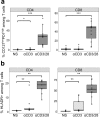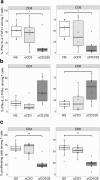TCR activation mimics CD127lowPD-1high phenotype and functional alterations of T lymphocytes from septic shock patients
- PMID: 30995946
- PMCID: PMC6472012
- DOI: 10.1186/s13054-018-2305-5
TCR activation mimics CD127lowPD-1high phenotype and functional alterations of T lymphocytes from septic shock patients
Abstract
Background: Sepsis is the leading cause of mortality for critically ill patients worldwide. Patients develop T lymphocyte dysfunctions leading to T-cell exhaustion associated with increased risk of death. As interleukin-7 (IL-7) is currently tested in clinical trials to reverse these dysfunctions, it is important to evaluate the expression of its specific CD127 receptor on the T-cell surface of patients with septic shock. Moreover, the CD127lowPD-1high phenotype has been proposed as a T-cell exhaustion marker in chronic viral infections but has never been evaluated in sepsis. The objective of this study was first to evaluate CD127 and CD127lowPD-1high phenotype in septic shock in parallel with functional T-cell alterations. Second, we aimed to reproduce septic shock-induced T-cell alterations in an ex vivo model.
Methods: CD127 expression was followed at the protein and mRNA levels in patients with septic shock and healthy volunteers. CD127lowPD-1high phenotype was also evaluated in parallel with T-cell functional alterations after ex vivo activation. To reproduce T-cell alterations observed in patients, purified T cells from healthy volunteers were activated ex vivo and their phenotype and function were evaluated.
Results: In patients, neither CD127 expression nor its corresponding mRNA transcript level was modified compared with normal values. However, the percentage of CD127lowPD-1high T cells was increased while T cells also presented functional alterations. CD127lowPD-1high T cells co-expressed HLA-DR, an activation marker, suggesting a role for T-cell activation in the development of this phenotype. Indeed, T-cell receptor (TCR) activation of normal T lymphocytes ex vivo reproduced the increase of CD127lowPD-1high T cells and functional alterations following a second stimulation, as observed in patients. Finally, in this model, as observed in patients, IL-7 could improve T-cell proliferation.
Conclusions: The proportion of CD127lowPD-1high T cells in patients was increased compared with healthy volunteers, although no global CD127 regulation was observed. Our results suggest that TCR activation participates in the occurrence of this T-cell population and in the development of T-cell alterations in septic shock. Furthermore, we provide an ex vivo model for the investigation of the pathophysiology of sepsis-induced T-cell immunosuppression and the testing of innovative immunostimulant treatments.
Keywords: CD127; Exhaustion; IL-7; Immunosuppression; PD-1; Sepsis; T-cell activation.
Conflict of interest statement
Ethics approval and consent to participate
This project was approved by our Institutional Review Board for Ethics (“Comité de Protection des Personnes Sud-Est II”), which waived the need for informed consent, as the study was observational and performed on residual blood, after the completion of routine follow-up (#IRB 11236). This study is registered at the French Ministry of Research and Teaching (#DC-2008-509), at the Commission Nationale de l’Informatique et des Libertés, and on ClinicalTrials.gov (ClinicalTrials.gov Identifier: NCT02803346). Non-opposition to inclusion in the study was registered for each patient.
Consent for publication
Not applicable.
Competing interests
FV, GM, EP, and JT are co-inventors in three patent families covering IL-7 receptor biomarkers. This does not alter the authors’ adherence to all the
Publisher’s Note
Springer Nature remains neutral with regard to jurisdictional claims in published maps and institutional affiliations.
Figures






References
-
- Shankar-Hari M, Phillips GS, Levy ML, Seymour CW, Liu VX, Deutschman CS, et al. Developing a new definition and assessing new clinical criteria for septic shock: For the third international consensus definitions for sepsis and septic shock (sepsis-3) JAMA. 2016;315:775–787. doi: 10.1001/jama.2016.0289. - DOI - PMC - PubMed
MeSH terms
Substances
LinkOut - more resources
Full Text Sources
Research Materials

